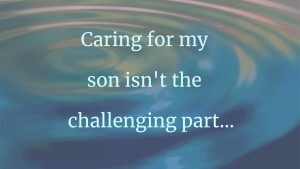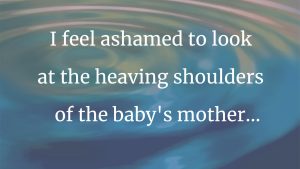Rachel Willis
Sitting with my mother in a white-walled exam room, awaiting the surgeon’s arrival, I felt happy.
Earlier this spring, I’d landed hard on one leg during a volleyball game and collapsed, hearing my knee make a terrible cracking sound, like all ten knuckles firing off. When I resumed playing, after several weeks of rehab, it happened again.
Now we were awaiting the MRI results.
You’d think I’d be nervous. I was seventeen, college-bound on a full-ride volleyball scholarship. Would this injury jeopardize that? But I felt glad–and touched with a kind of glamour. During hundreds of boring or grueling practices, I’d longed to sprain an ankle or break a leg. Now I had an iron-clad excuse to duck the huge workout packet my college coach had sent.
My doctor bounded in. A tall African-American man in his fifties, with white hair and beard, he radiated energy.
I liked him–his energy, the contrast of his bright white hair and brilliant smile with his dark skin.
Swiftly, he pulled an MRI image from its envelope, clipped it to a board and pointed.
“That,” he said, “is your knee. And this is your ACL, your anterior cruciate ligament. You can see”–he flashed a bright smile–“that it’s torn completely through.”
My mom’s eyes misted over; I fought the urge to roll my own. A knee injury wasn’t something to cry over. It would sideline me, yes, but I’d recover.
I learned that I needed surgery–and that this energetic, fifty-something doctor specialized in knee repairs. He would be happy (thrilled!) to do mine.
In replacing my ligament, we had various options. I chose the cadaver replacement: It required a longer recovery time. Skipping that summer workout plan was now a definite.
When the doctor asked about post-surgery rehab, I told him about my college plans for the fall.
“That’s great!” he said. “The college athletes I work with typically do rehab through their sports programs.” After a season of rehab, he predicted, I’d be back on the court at the top of my game.
As we left, my mom put her arm around me. I rolled my eyes again. “Mom, I’ll be fine. People hurt their knees all the time.” I was looking forward to a rest–spending time with friends on weekends, having time for homework after school….
She wiped away a tear. “I know. The surgeon sure seemed excited about it, didn’t he?”
I laughed. “Aw, Mom, I like him. He’s a little hyper, but he knows his stuff.”
The surgery was slated for June, a few months off. I spent these months watching the muscles around my knee atrophy, and cheering my former teammates to victory in match after match. I didn’t like watching volleyball–I wanted to be out on the court–so I enjoyed myself in other ways. Soon after the surgery I’d leave for college, where my coach had promised to start me on rehab, so I relished this rare time off.
The nurses threw a hospital gown my way, then left.
At 5:00 am on the day of the surgery, as we drove to the medical center, I felt scarily hungry.
I also felt the glamour start to drain away.
The nurses threw a hospital gown my way, then left. The gown’s immodesty appalled me. How does this thing go on? Should I take off my underwear? I donned the gown and sat on the bed.
A rap on the door.
My doctor eagerly strode in. Gazing at my knee, now shrunken from disuse, he rubbed his hands, looking like a kid happily eyeing a favorite toy.
“I’m going to make you new again,” he said.
I hoped so; I felt anxious to resume my old role as a star athlete. If I couldn’t be a stand-out volleyball player, I wasn’t sure who I’d be.
Distracted by the unfamiliar surroundings and bustling medical personnel, I didn’t even feel the anesthesia kick in.
I awoke in a recovery cubicle, feeling angrily that I’d been ambushed, robbed of myself. My first sensations were of heaviness and pain–the blankets weighing down my limbs, the throbbing ache of my leg. I would have thrashed about, but I could barely move.
When next I opened my eyes, I felt my mom’s fingers squeezing mine. The pressure bothered me; I lurched in protest. This upset my innards, and I began to heave. The nurse quickly placed a basin under my head.
To this day, I appreciate that woman. When I demanded something to eat, she brought it soothingly. When I threw up again, she rubbed my back, her cool hands refreshing my skin. When I began shivering, she brought a lighter blanket to warm me without weighing down my aching leg.
As my nausea eased, she and my mom readied me to leave.
The surgeon sprang into the cubicle.
“I brought you these!” he crowed, waving a manila envelope. “You’ll love ’em!”
The envelope landed on the bed, and he was gone.
Again, I was struck by his contrasts–the quick energy in a middle-aged body and, as I now saw, the carefree dealing with trauma and suffering, seemingly with no expectation that we would take any of it to heart.
Clearly, he loved his job; he did this procedure all the time, was good at it. And I’d been an easy patient who hadn’t once asked him to honestly tell me any of its downsides.
I hadn’t expected to suffer this pain, to feel so disoriented and sick. No one had warned me beforehand, probably because there was no point. I’d wanted to feel cavalier about this whole process, and my surgeon’s bright promises had matched my attitude perfectly.
My mom’s thinned lips told me how offended she felt.
And my wan, half-hearted smile told her that I was finally seeing this surgery for what it really meant–a lengthy recovery accompanied by a substantial amount of pain and some harsh emotional implications.
Listlessly, I emptied the envelope’s contents onto the bed.
They were pictures taken during surgery: white, bloodless ligaments and bone. One of the photos featured my newly installed cadaver ligament.
Over the ligament, the surgeon had drawn a happy face.
My mom’s lips tightened disgustedly. I think she was guessing at my future–and she was right.
When I got to college, I began a rehab program cobbled together by a student athletic trainer who hadn’t yet formally studied rehabilitation. Too inexperienced (and still a bit too cavalier) to protest, I did what I was told–but it wasn’t nearly enough.
I didn’t regain my former strength for another two years. By then, I’d missed two seasons and had to re-learn most of my volleyball mechanics. My passion for the sport atrophied into a bench-sitter’s bitterness and frustration.
It took me ten years to recover my vertical jump, speed and agility. Whenever I played, whether for my college team or for fun, I struggled with feelings of insecurity, timidity and self-consciousness.
Together, my surgeon and I had drawn a happy face over a cadaver–but I couldn’t keep it there, no matter how I tried.
About the author:
Rachel Willis is a graduate student at Lynchburg College and an adjunct instructor of English at Liberty University. She played volleyball for the Liberty University Flames and now coaches the sport with her husband at Randolph College. “Writing has always been my way to work out the stuff of life. Writing stories, whether fiction or nonfiction, gives experience a voice that I find difficult to articulate in any other way.”
Story editor:
Diane Guernsey







